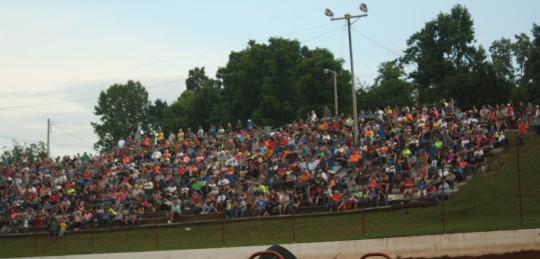If you watched any of the Brickyard 400 from the Indianapolis Motor Speedway this past Sunday you could not have missed the fact that there were more empty seats surrounding the world’s most famous race track than there were filled ones. And if you were on social media during that same time frame you could not have missed numerous NASCAR apologists who inhabit sites such as Twitter and Facebook telling you to ignore the empty seats and focus on the racing.
Unfortunately, there were two problems with the advice you were being given. The first is that in much the same way it is impossible to ignore a large elephant in a small room, it was impossible to ignore something so obvious as the lack of fans attending what is considered one of the most significant races on the Monster Energy NASCAR Cup schedule. Secondly, the racing wasn’t great.
Granted, the 2017 Brickyard 400 will likely be remembered by many for the dramatics of the closing 20 laps or so. But the 140 circuits it took to get to that point could be summed up by pointing out that two cars(those of Kyle Busch and Martin Truex, Jr.) completely dominated the race to such a degree that it was completely obvious to anyone watching that no one else was in their league until they managed to take each other out. After that, the race turned into a fuel mileage contest until the late-race chaos broke out.
So, putting your focus on the “great racing” was not the answer.
But back the point of poor attendance. To pretend it is not important that so few people were actually on hand to take in a crown jewel race is totally ridiculous. It absolutely matters and it is a story. If TV and Twitter personalities do not think diminished attendance at race tracks is an issue, almost certainly shareholders in Speedway Motorsports, Inc. and International Speedway Corporation do as both of those companies have reported losses in 2017. And that is taking into account that comparisons are being made with previous years which were also weak.
If, on any given Sunday, there were to be such a high of a percentage of empty seats in NFL stadiums it would be huge story. The same is true of any other sporting event with the possible exception of Major League Baseball which plays a 162 game schedule with many games taking place on weekdays.
No, people do not attend sporting events like they used to. As a result, numerous venues have had to downsize so that they “can improve the fan experience”. In other words, these improvements have been made so they can hide the fact that attendance has dropped off. But at many NASCAR tracks, the fall in attendance is so extreme that it cannot be hidden.
That said, it feels like if the stakeholders in NASCAR are doing little to combat the drop off(and no, this is not a story about the multitude of format changes). Ticket prices remain high for desirable seats at most races. “Affordable family packages” and other deals tend to offer seats in the lower parts of grandstands where visibility is limited, especially at tracks of more than one mile in length.
A check of the official website of the Bristol Motor Speedway reveals that a significant number of tickets are still available for their ‘Bass Pro Shops NRA Night Race’ with prices near the same level as when the track saw much better attendance numbers than has been the case in recent years.
‘Verified Resale Tickets’ for the event to be held on August 19th begin at $72 when the ‘Lowest Price’ option is clicked. Face value seats with ‘White Flag Sale’ prices start at $95 for lower rows with higher level seats going at a rate of well over $100. It doesn’t take much of a mathematician to figure that four tickets would approach or exceed the $300-400 range and that’s aside from parking, concessions and souvenirs. Those are near to Orlando-area attraction prices.
Richmond International Raceway hosts the Federated Auto Parts 400 in September which is billed as the playoff deciding event on the Monster Energy NASCAR Cup schedule. Tickets for that race are listed on the track’s website in a range of $45 for low level seats up to $120. Again, those prices could put a family of four in the $300-400 range minus the extras.
Based on the seating maps of both tracks, it appears as if there are many tickets still available to races that were once virtually guarantees to sell out.
If local dirt tracks operated under this same model, they would go broke in short order. Those facilities routinely offer reduced pricing for grandstand admission and concession deals to draw fans in, particularly for their weekly shows. Special events such as those sanctioned by the Lucas Oil Late Model Dirt Series and the World of Outlaws Late Models typically command higher prices at the ticket booth, but those are special events. Granted, all NASCAR races are special events, but in some cases, they are the only racing events held at some tracks.
Of course, the big difference between your local dirt track and NASCAR is the amount of television revenue received by each. NASCAR takes in vast amounts from its TV partners while local takes make nothing. Whether it’s true or not, many fans have developed the perception that NASCAR and its tracks have become indifferent regarding their attendance. And is often the case, perception becomes truth in many cases when no change occurs to prove otherwise in the minds of those affected.
It almost feels like NASCAR is arrogantly trying to live like it’s the early 2000’s when the sport reached its peak of popularity even though evidence in clear that the bubble has burst.
The thing that is essential to remember is that television revenues can’t save everything. Although the sport is currently receiving huge amounts of money from its partners, the ratings have been down throughout much of the 2017 season. As was the case this past year when NASCAR hoped to bring in huge amounts of money with the sale of the naming rights for its top series, they may find themselves earning much less than expected when the next TV contacts are doled out.
So again, attendance at the track matters. Scenes shown on the various sports highlight shows that reveal large numbers of empty seats are not only embarrassing but offer the image of an unhealthy sport with waning interest levels to those who may not follow regularly. And more, it would seem difficult to sell the idea of coming into the sport to a prospective company that is being courted to sponsor a team or race if they look around and see so much emptiness.
Numerous local tracks have closed over the past decade because they were not able to overcome poor attendance on race day. NASCAR and other “big time” racing bodies are not immune from this possibility. So please, do not treat fans like they are dumb and tell them that attendance doesn’t matter or to stop focusing on empty seats. Those things do matter to the bottom line and to the health of the sport.
It is a part of the story and attendance does matter.
To interact with us on social media, follow @RichardAllenIDR & @MichaelRMoats on Twitter or Like our Facebook page.








